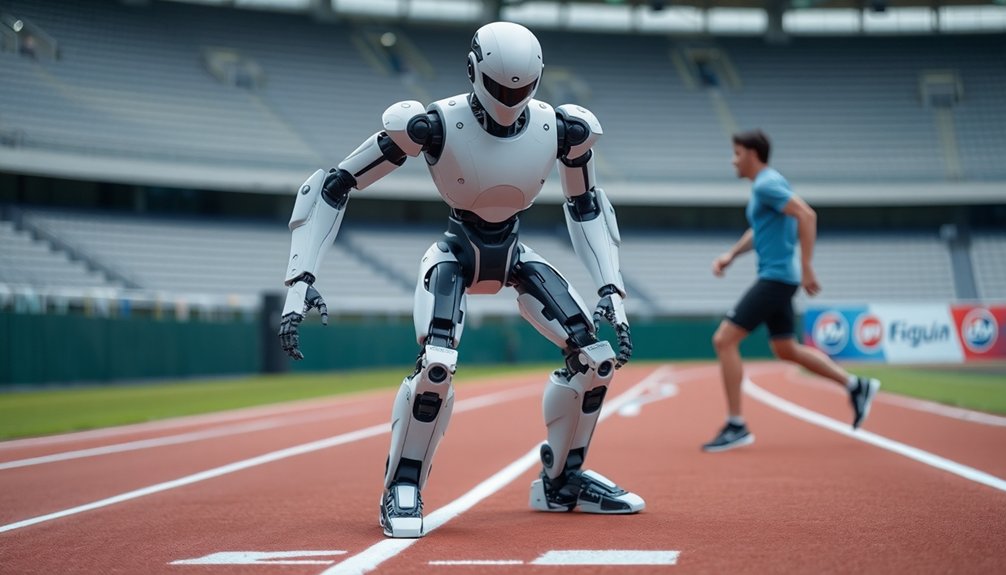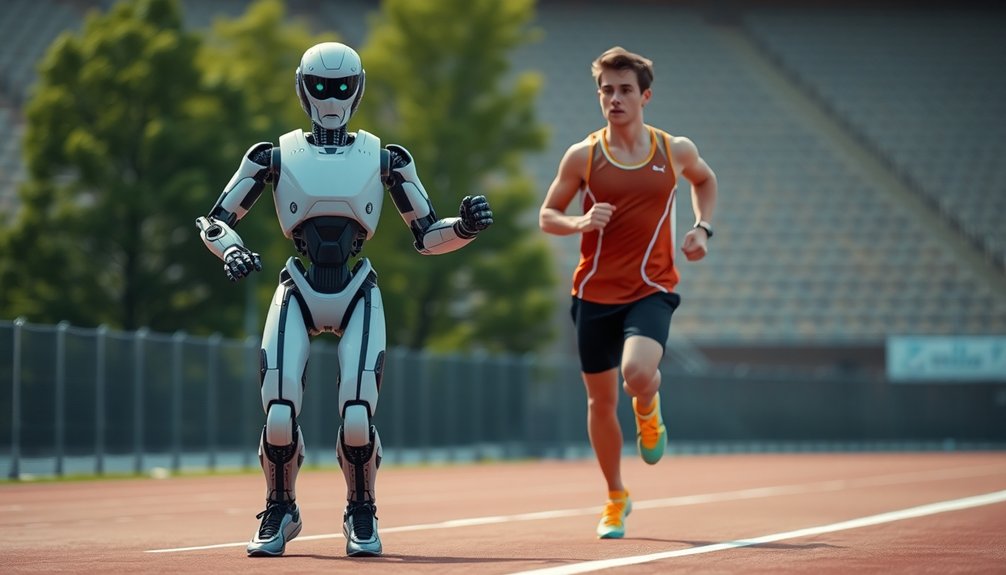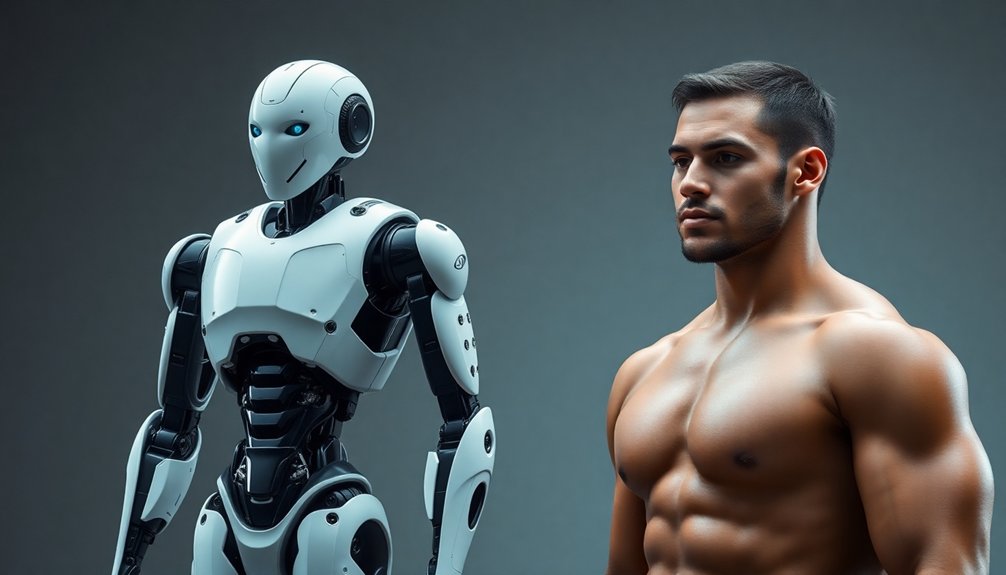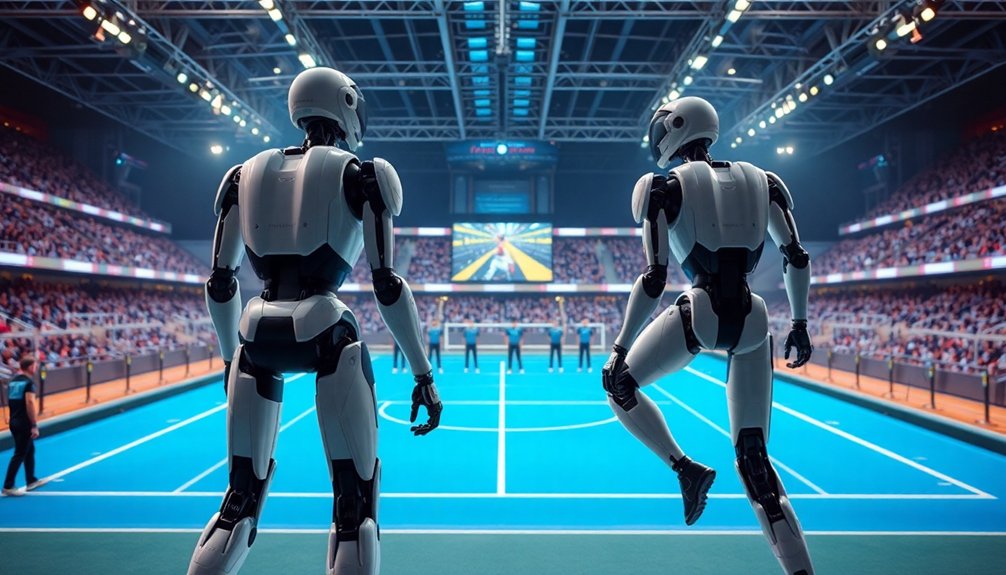Table of Contents
Currently, robots are athletic underdogs with impressive potential but serious limitations. They’re fast learners with killer AI, but still struggle with human-level endurance and complex movements. Top robotic athletes can sprint around 7.5 mph compared to human speeds of 27 mph, and they tire quickly. While technological breakthroughs are mind-blowing, humans still dominate athletic performance. Want to know how close robots are to outrunning us? Stick around, because the future’s getting weird.
The Rise of Athletic Humanoid Robots

When most people hear “robot,” they probably picture a clunky metal contraption from an old sci-fi movie.
But today’s robots are nothing like those rusty relics. We’re witnessing a revolution where robots aren’t just programmed machines—they’re athletic competitors. Isaac Gym’s virtual simulation technology enables these robots to learn complex movements through thousands of simultaneous training iterations, dramatically accelerating their athletic potential.
The upcoming 2025 World Humanoid Robot Sports Games will showcase robots sprinting, jumping, and even dancing with jaw-dropping precision. Imagine robots competing in track and field, performing gymnastics, and playing soccer—they’re not just mimicking human movements, they’re challenging our understanding of athletic performance.
These aren’t just fancy toys; they’re sophisticated machines designed to adapt, move with incredible agility, and potentially outperform humans in specific physical tasks. Models like Atlas have demonstrated remarkable robotic athletic capabilities, showcasing bipedal movement and complex physical coordination that push the boundaries of traditional robotics.
The Boston Dynamics Electric Atlas, with its exceptional locomotion design, represents a breakthrough in robotic mobility and dynamic movement performance.
Who would’ve thought robots could become serious athletes?
Breaking Down Half-Marathon Performance
While robots might dream of marathon glory, human half-marathon performance reveals just how complex endurance running genuinely is.
We’re talking about humans sustaining blistering 4:19-mile paces for 13.1 miles—a feat that makes most machines look like toddlers learning to walk. Jacob Kiplimo’s world record of 56:42 isn’t just speed; it’s a symphony of physiological magic. Performance data tracking shows that human athletes continuously improve their times through meticulous statistical analysis and strategic training. Training adaptation strategies demonstrate how elite runners systematically enhance their cardiovascular efficiency and muscular endurance.
Robots can calculate numbers, but can they dynamically adjust stride, regulate temperature, and strategize mid-race? Not a chance.
Mechanical precision meets human complexity: a race where algorithms crumble and adaptability reigns supreme.
Our bodies optimize movement, recover from fatigue, and push through environmental challenges that would short-circuit any humanoid competitor.
Half-marathon performance isn’t about raw power—it’s about adaptive intelligence, resilience, and that ineffable human spark that turns running into poetry.
Technological Breakthroughs in Robotic Movement

Because robots have long been the clunky, awkward cousins of human movement, recent technological breakthroughs are turning that reputation on its head.
We’re witnessing a robotics revolution that’s making machines move like they’ve got something to prove.
Key technological leaps include:
- Advanced sensors that give robots near-superhuman environmental awareness
- Artificial muscles that flex and respond with shocking precision
- Real-time AI processing that helps robots adapt faster than you can blink
- Motion capture techniques stealing moves directly from human performers
- Reinforcement learning that lets robots basically teach themselves complex movements
Imagine a robot that can cartwheel, breakdance, and maybe even outperform your weekend warrior fitness routine. Neural network algorithms are enabling robots to analyze and optimize their movement strategies with unprecedented precision.
Humanoid robots in healthcare settings are demonstrating advanced movement capabilities that challenge traditional perceptions of robotic mobility.
Companies like Boston Dynamics are pushing the boundaries of robotic mobility and agility, showcasing unprecedented physical performance in humanoid systems.
We’re not just talking incremental improvements—we’re talking a fundamental reimagining of machine mobility.
Who’s clunky now?
Simulating Human Athletic Capabilities
If robot designers could bottle human athletic prowess, they’d be selling miracle elixirs. Our quest to simulate human movement is a wild ride of tech wizardry and physics-bending experiments. Neural network algorithms enable robots to learn complex movement patterns with increasing precision and adaptability. We’re turning human motion into robot choreography through clever tricks like motion capture and video-based training. Humanoid motion simulation allows researchers to transform complex human athletic techniques into reproducible robotic movements across multiple sports environments. The Humanoid Robotics Challenge provides a critical platform for advancing these cutting-edge robotic movement capabilities.
| Simulation Technique | Performance Impact |
|---|---|
| Motion Capture | High Movement Accuracy |
| Video Conversion | Dynamic Skill Learning |
| Physics Integration | Real-World Adaptation |
| Delta Action Models | Enhanced Agility |
The ASAP framework is basically athletic robot bootcamp, transforming clunky machines into movement mavens. By bridging simulated and real-world physics, we’re teaching robots to move like Cristiano Ronaldo—minus the soccer drama. Sure, current humanoid robots look more awkward than graceful, but we’re getting closer to turning sci-fi fantasies into jaw-dropping reality.
Endurance Challenges for Robotic Athletes

We’ve watched robots attempt marathons, and let’s be honest: it’s like watching toddlers run a triathlon.
The Beijing humanoid half-marathon proved just how far we’re from creating mechanical athletes that can match human endurance, with only six out of twenty robots actually finishing the race.
What’s becoming clear is that while our robotic friends can technically move forward, they’re still struggling with the fundamental challenge of sustained performance—kind of like that one friend who talks big about fitness but gets winded climbing stairs.
Mechanical design challenges make it incredibly difficult for humanoids to replicate the complex, nuanced movements required for long-distance running.
Humanoid robots are currently experiencing massive cost reductions and technological improvements, suggesting that robotic performance limitations will likely be overcome in the near future as industrial robotics investments continue to drive technological advancements in precision engineering and automation.
Robot Race Performance
When humanoid robots decided to crash the marathon scene, nobody expected a tech-meets-athletics spectacle quite like the Beijing Yizhuang Half Marathon.
These mechanical athletes stumbled, trembled, and somehow powered through 21 entries with wildly mixed results.
Our robotic runners proved both impressive and hilarious:
- Only six robots actually completed the entire course
- Tien Kung Ultra set the pace at a glacial 2 hours and 40 minutes
- Mechanical failures turned the race into an unintentional comedy show
- Robots struggled to maintain basic upright posture
- Human winners cruised past their metallic competitors with ease
Let’s be real: these robots aren’t replacing human athletes anytime soon.
They’re more like enthusiastic toddlers learning to walk—wobbly, determined, and occasionally face-planting.
But hey, everyone’s gotta start somewhere, right?
Continuous learning and adaptation will be crucial for robots to improve their performance in physical challenges like marathons, just as the knowledge base suggests technological advancement requires ongoing skill development.
Physical Stamina Limits
Because endurance sounds simple on paper, robotic athletes quickly discover it’s anything but a walk in the park.
Battery limits and heat management crush their dreams faster than a human sprinter leaves them in the dust. We’ve watched robots struggle through basic tasks, their energy reserves draining like a smartphone on its last 5% during a long road trip.
Thermal challenges and mechanical wear turn promising prototypes into glorified paperweights. Sure, they can nail repetitive factory work, but sustained athletic performance? Not so much.
The harsh reality is that our mechanical friends burn through power reserves while humans metabolically cruise, adapting to challenges with biological efficiency that makes robots look like awkward, energy-starved cousins in the performance Olympics.
Speed and Agility: Robots vs. Humans
Racing against humanoid robots might sound like a sci-fi fantasy, but the speed and agility showdown between machines and humans is already heating up.
The futuristic face-off between human speed and robotic agility has begun, turning science fiction into reality.
These mechanical challengers are pushing boundaries, though they’re still playing catch-up in the speed department. Our robotic competitors bring some serious skills to the track:
- Top robot speeds max out around 7.5 mph, while human sprinters blow past at 27 miles per hour
- Advanced software helps robots make real-time movement decisions, mimicking human athleticism
- Specialized robotic footwear and aerodynamic designs are leveling the performance playing field
- Lightweight materials and intelligent leg designs improve running efficiency
- Battery power and sophisticated programming enable longer endurance compared to early robot models
Will robots eventually outpace human athletes? The race is on, and we’re watching every step.
Physical Limitations of Humanoid Robots

Speed’s exciting, but reality check: humanoid robots aren’t exactly Olympic material.
They’re more like awkward teenagers learning to walk — slower, clunkier, and way less graceful than human athletes. We’re talking fewer muscles, limited motor skills, and movements that look like they’re perpetually stuck in slow motion.
Imagine a robot trying to sprint: it’d probably trip over its own feet while a human athlete breezes past. Their body design mimics humans, but with significant limitations. They can carry specific payloads and navigate tricky terrain, but don’t expect them to win any gold medals.
Energy efficiency? Forget about it. These mechanical athletes burn way more energy doing tasks that humans accomplish effortlessly.
They’re improving, sure, but for now, they’re more “participation trophy” than champion material.
Training Techniques and Motion Data
We’re pushing the boundaries of robotic movement by mapping human performance onto virtual simulations that help humanoid robots learn faster and more intuitively.
Our research shows that by analyzing athlete motion data and translating complex movements through advanced algorithms, we can gradually bridge the gap between mechanical precision and human-like agility.
Imagine robots that can’t just mimic a basketball player’s jump shot, but understand the nuanced muscle memory and split-second decision-making that makes athletic performance so remarkable.
Virtual Motion Simulation
As virtual motion simulation transforms athletic training, athletes are discovering a technological crystal ball that peers into their performance potential.
We’re diving into a world where robots might just be the ultimate training partners, offering insights that human coaches can only dream about.
- Motion capture tracks every muscle twitch with laser-like precision
- AI algorithms decode performance data faster than you can blink
- Immersive environments simulate high-pressure scenarios without real-world risks
- Remote coaching breaks geographical boundaries like they’re paper walls
- Personalized training plans emerge from data points that tell your athletic story
Imagine practicing your perfect swing or pitch without bruises, analyzing each movement with surgical accuracy.
Virtual simulation isn’t just training—it’s performance optimization on steroids, minus the actual steroids.
Human Performance Mapping
When human performance meets cutting-edge technology, something magical happens: we reveal the hidden potential inside every athlete’s body. Motion capture isn’t just fancy cameras tracking movement—it’s like having a performance detective that breaks down every muscle twitch and joint angle.
We use sensors and advanced software to create 3D models that expose an athlete’s strengths and weaknesses faster than you can say “biomechanical analysis.” Want to know how to run faster or jump higher? These tools track everything from your stride length to your muscle activation patterns.
Real-time feedback means athletes can instantly adjust technique, preventing injuries and boosting performance. It’s like having a coach who sees everything, understands everything, and can predict your next move before you even make it.
Robotic Movement Optimization
Robotic movement optimization isn’t just about creating mechanical mimics of human motion—it’s about teaching robots to dance with precision that would make professional choreographers jealous.
We’re using cutting-edge techniques to transform clunky machine movements into something extraordinary:
- Machine learning algorithms slice through complex motion data like a hot knife through butter
- Particle swarm optimization helps robots learn walking patterns faster than a toddler on espresso
- Motion capture technology translates human movement into robotic choreography
- Genetic algorithms evolve movement strategies through digital survival of the fittest
- Parallel learning methods train robots simultaneously, multiplying their learning speed exponentially
The goal? Creating humanoid robots that move with such grace and efficiency that they’ll make human athletes look like they’re walking through molasses.
Who said robots can’t have style?
The ASAP Framework: Revolutionizing Robot Movement
While humanoid robots have long struggled to move with the grace of their human counterparts, the ASAP framework might just be the game-changer we’ve been waiting for.
It tackles the pesky problem of robots moving like stiff, awkward machines by bridging the gap between simulation and reality. How? By using a clever two-stage approach that pre-trains motion in virtual worlds, then fine-tunes those movements with real-world data.
Think of it like teaching a robot to dance by first practicing in a video game, then getting coaching from a pro dancer.
The result? Robots that can track human motions with shocking precision, reducing tracking errors and making those mechanical movements look almost — dare we say — natural.
This isn’t just incremental improvement; it’s a potential revolution in robotic mobility.
Future of Robotic Sports and Competition

We’re witnessing the birth of emerging robotic athletic platforms that’ll make our current sports look like child’s play – imagine soccer matches where robots hustle faster than Messi and gymnastic routines more precise than Olympic champions.
Robot-human sports fusion isn’t just a sci-fi fantasy anymore; it’s becoming a reality where mechanical athletes might soon compete alongside their human counterparts in ways we’re only beginning to understand.
The technological performance evolution suggests that within a decade, we could see humanoid robots not just mimicking human movements, but potentially redefining what athletic performance means – challenging our very understanding of competition, skill, and the boundaries between machine and human capability.
Emerging Robotic Athletic Platforms
As technological innovation accelerates, humanoid robots are transforming from sci-fi fantasies into legitimate athletic competitors.
We’re witnessing a radical shift in sports technology that’s blurring the lines between human and machine performance.
Key emerging robotic athletic platforms include:
- Precision training simulators that analyze athlete movements with millimeter-level accuracy
- Humanoid robots capable of completing half-marathons and participating in multi-disciplinary sports events
- AI-powered systems that can replicate complex athletic scenarios without physical risk
- Data-driven platforms generating unprecedented performance insights
- Scalable robotic technologies adaptable to various training environments
The 2025 World Humanoid Robot Sports Games in Beijing will showcase these platforms, proving robots aren’t just mechanical curiosities but potential game-changers in athletic performance.
Who’s ready to watch a robot sprint?
Robot-Human Sports Fusion
From precision training simulators to AI-powered performance platforms, robotic athletic technology has been steadily building momentum.
We’re observing humanoid robots transform from clunky machines to potential sports competitors, challenging everything we understand about athletic performance.
Imagine robots sprinting alongside humans in half-marathons, their gyroscopic sensors calibrating every micro-movement with inhuman precision.
Sure, they’re not perfect — yet. These mechanical athletes stumble, malfunction, and occasionally face-plant, but each failure teaches engineers something vital.
Beijing’s robot sports games prove we’re not just dreaming; we’re engineering a future where machines might outpace human limitations.
Will robots eventually dominate sports? Probably not tomorrow.
But the trajectory is fascinating: each race, each competition inches us closer to a world where technology and human potential blur into something extraordinary.
Technological Performance Evolution
Because robots are about to crash the sports party, we’re looking at a technological performance evolution that’ll make Olympic trials look like a middle school field day.
These mechanical athletes are leveling up faster than anyone predicted, and they’re not just here to participate—they’re here to compete.
Our robotic future looks like this:
- Humanoid robots hitting 12 km/h with shocking precision
- AI algorithms that can literally run circles around human strategy
- Battery tech that’s rapidly solving endurance challenges
- Custom running shoes engineered for maximum mechanical efficiency
- Global competitions turning robots into legitimate athletic contenders
Who’ll win when silicon meets muscle?
The smart money’s on the machines that never get tired, never lose focus, and are constantly upgrading themselves. Game on.
Bridging the Gap Between Human and Robotic Performance

When humanoid robots first stumbled onto the athletic scene, most people thought they’d be glorified tin cans barely capable of a wobbly walk.
But we’re witnessing something revolutionary: robots are closing the performance gap faster than anyone predicted. They’re running half-marathons, mimicking human gaits, and challenging our assumptions about mechanical limitations.
Sure, they’re still slower and less efficient than elite athletes, but that’s changing rapidly. Engineering breakthroughs are transforming these machines from clunky prototypes to potential competitors.
Robotic athletes: once sluggish, now rapidly evolving through groundbreaking engineering toward competitive potential.
We’re seeing robots with specialized designs that optimize movement, and remote operation technologies that push their capabilities.
The fascinating part? Each technological leap isn’t just about speed—it’s about reimagining what’s possible when human creativity meets robotic precision.
Who knows? Future robot athletes might make today’s performances look like ancient history.
People Also Ask
Can Humanoid Robots Experience Pain or Fatigue During Physical Challenges?
We can’t experience pain or fatigue like humans do. Our mechanical systems detect damage and limitations, but we don’t feel physical stress emotionally. We respond through safety mechanisms and performance monitoring, not sensory suffering.
Will Robots Eventually Replace Human Athletes in Competitive Sports?
Like a lightning bolt striking innovation’s horizon, we don’t believe robots will fully replace human athletes. They’ll likely complement sports, enhancing performance and creating new competitive formats that blend human skill with technological precision.
How Much Do Humanoid Robots Cost to Develop and Train?
We’re looking at hefty development costs for humanoid robots, ranging from $500,000 to $1 million initially. By 2025, component costs are expected to drop to around $35,000 per unit, making them increasingly affordable.
Are There Ethical Concerns About Robots Competing Against Human Athletes?
We’re deeply concerned about ethical issues in robot-human sports, including fairness, technological advantages, potential psychological impacts on athletes, and the challenge of maintaining equal competition standards in an increasingly technological landscape.
What Safety Measures Prevent Robots From Malfunctioning During Competitions?
With 78% of robotic competitions implementing strict safety protocols, we guarantee robots’ reliability through emergency shutdowns, redundant control systems, and continuous performance monitoring, preventing potential malfunctions that could endanger participants or spectators.
The Bottom Line
As we look ahead, robotic athletes are racing toward human-level performance—not to replace us, but to challenge our understanding of movement and potential. Will humanoids one day sprint past our biological limits? Perhaps. But the real victory isn’t about who’s faster; it’s about how technology expands our collective imagination of what’s possible. The finish line isn’t a competition, it’s a collaboration between human innovation and mechanical precision.
References
- https://www.therunningweek.com/post/robots-vs-humans-the-future-of-racing-begins-in-china
- https://torontostarts.com/2025/06/04/robot-marathon-humanoid-robots-performance/
- https://www.youtube.com/watch?v=ak6Mwoahtjg
- https://www.ainews.com/p/these-humanoid-robots-can-now-move-like-ronaldo-and-lebron-james
- https://en.clickpetroleoegas.com.br/robos-humanoides-participam-de-primeira-meia-maratona-e-nao-conseguem-superar-desempenho-humano-em-teste-inedito/
- https://www.youtube.com/watch?v=fBFwFyZbewo
- https://qviro.com/blog/humanoid-robots-all-models/
- https://humanoidroboticstechnology.com/articles/top-12-humanoid-robots-of-2025/
- https://english.kyodonews.net/news/2025/05/1666816e5652-chinese-startup-shows-off-applications-of-race-winning-humanoid-robot.html
- https://www.rudebaguette.com/en/2025/05/beijing-launches-worlds-first-humanoid-robot-sports-games-as-machines-compete-for-glory-in-jaw-dropping-showdown/
